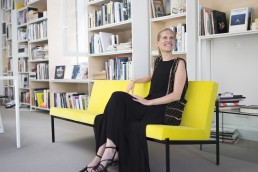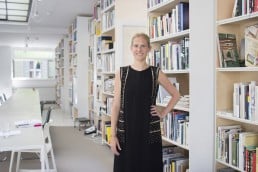Interview: Karoline Pfeiffer of Independent Collectors
For this series Art Insiders interviewed 5 Berlin-based women that work on the intersection of art and digital technology. Find out what these frontrunners have to say about Berlin’s art and tech scenes, the current status of the art world, and in what ways digital technology is affecting it.
Karoline Pfeiffer is Director at Independent Collectors, the world’s first and largest international online community for collectors for contemporary art. She is an active member of Berlin’s art scene, and is regularly involved in organizing events and projects that focus on the crossover between art and tech.

Could you tell us a bit about your background and about Independent Collectors?
I very traditionally studied art history, as well as theatre science and history in Berlin and Paris. I always worked in the art business in various sectors, with galleries, collections, foundations, and with artists. I started working for Independent Collectors in 2013 with Christian Kaspar Schwarm, the founder, and three other lovely colleagues.
Independent Collectors’ main vision is to showcase privately owned art to a broader audience. We work closely with many collectors who show their collections on the website. We like to work with both established collectors as well as emerging collectors, as we want to show this range of diversity in collecting, which also has to do with the claim that anyone can be a collector. We want to show a capsule of a new era of collecting. Since Independent Collectors is an online platform, we don’t depend on a specific location and we’re able to work on a global level. We’re very international and can reach collectors worldwide. The collections displayed on our website range from large collections to collections of younger collectors – from pulsating urban centers to tranquil provinces.
“I THINK THE DIGITAL AND PHYSICAL EXPERIENCE CAN CO-EXIST. THEY SHOULD BE SEEN AS A YING AND YANG, WHERE THE OLD AND NEW WORLDS MERGE TO WORK TOGETHER AND COMPLEMENT EACH OTHER.”
What about these meet-ups that you organize, aimed at getting people together that work on the intersection of art and tech?
This started three years ago, and I got this idea from the tech world, where they often organize these type of meet-ups to get like-minded people together to exchange ideas and knowledge. I started this with Euphemia from curart, to build this community for people that work in the online aspect of the art world. People come together from online auction houses, online art platforms, institutions and other art-related companies, that are connected with the digital world. At the moment we’re over thirty start-ups and companies from Berlin, aimed at bringing in new ideas and organizing events that focus around exploring a particular topic. The Beta Manifest for example, was developed last year together with Thea Dymke from the Association of German Galleries and Art Dealers (BVDG) in collaboration with Independent Collectors. The Manifest consists of ten theses focus on the digital art market, and tackles some issues and challenges around this topic. It is a continuous work in progress, where we now have this base that we can work from.
In my opinion the online art market is just in an early beginners’ stage. The solutions that have come up in the art world up until now only involved trying to bring the analogue world into the digital world, instead of fully integrating these two. There is still a certain link missing that will allow for this synergy between the art and tech world. In my opinion, these worlds are very similar in many ways, as there is this creative dynamic in both, but on the other hand they’re worlds apart. I think that there’s so much potential to create something completely new, that we cannot even fathom yet at this moment.
“ONLINE ART PLATFORMS OPEN UP THE SCENE TO THOSE WHO FELT LIKE THE ART WORLD WASN’T AVAILABLE FOR THEM, OR FELT ALIENATED BY IT IN THE PAST.”
Do you find digitalization in the art world has already led to a certain degree of democratization and transparency in the art market?
I see all these new art platforms popping up on a daily basis, with the motivation to sell art online and aim for democratization and transparency and I think this is fantastic. Many people who aren’t used to visiting galleries and can feel intimidated by the art world, but on the other hand have some money to spend and are very curious towards art and the art market. These platforms open up the scene to those who felt like the art world wasn’t available for them, or felt alienated by it in the past. It gives them the opportunity to educate themselves and break these barriers, since they can navigate the art market without having to follow the strict social codes that are so present in the art world. Furthermore, through platforms like Independent Collectors, collectors are more willing to present their collections online and get these artworks out in the open. It really reveals a part of the art world that would otherwise remain hidden and behind closed doors.
I also think that Instagram is a great channel for artists to communicate their vision and mindset to a new and broader audience. It allows artists to promote their art, but also add personality to their artistic output and create a strong brand for themselves. You’re more inclined to like art when you can relate to the artist behind it on a more personal level, and Instagram is a great way to bring artists and collectors together that otherwise might not have crossed paths. Instagram is a very visual platform, which allows for people to be drawn to an artwork for its aesthetic value first, and only economic value second. It can also be used as a research source for collectors.

What do you consider successful examples of institutions and people in the art world who actively champion the intersection between art and tech?
Good examples of collectors that are really trying to push digitalization in terms of collecting digital art, but also displaying their collections online, are Poju and Anita Zabludowicz, Alain Servais, and Sylvain and Dominique Levy. For collectors like these, implementing digital means of communication is already such an integrated part of the way they collect, that they don’t feel the need to over-sell it.
In what ways do you find digitalization has already changed the art world?
First of all, you don’t have to be physically present anymore to be able to experience art to a certain extend. I don’t think that this replaces the physical experience of course, since I do think that art is a full-body experience. But there is this overwhelming number of art fairs, gallery exhibitions, private collections and museum shows worldwide, and now you can get a feel of what those events are like in real time. This allows you to make an educated decision on what you do choose to see in person, as it enables you to determine beforehand whether an exhibition will be your taste or of interest to you or not.
However saying that, I don’t think an online experience should be treated as a replacement for viewing art in real life, but I think the digital and physical experience can co-exist. They should be seen as a Ying and Yang, where the old and new worlds merge to work together and complement each other. There is so much opportunity in having the art world and digital world interact. But it’s necessary to get past the current idea of merely trying to bring the analog art world in to the digital world. We must really work towards synergy between both worlds, and create this symbiotic system where a physical art experience is complemented by a valuable digital experience. I think there is something brooding under the surface that we can’t quite grasp yet, but it’s there and ready to come out.
About Art Insiders
Art Insiders is a multidisciplinary agency focused on the arts and culture sector.
Website: artinsiders.org
Get your free copy of Artland Magazine
More than 60 pages interviews with insightful collectors.